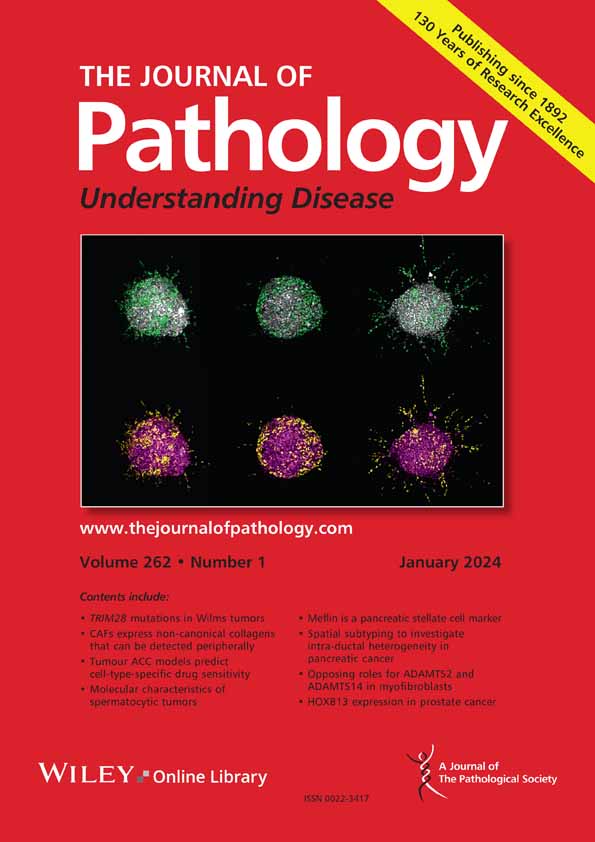Saiganesh Sriraman, Verneri Virtanen, Antti Kukkula, Mervi Toriseva, Anni Lumiainen, Gun West, Matti Poutanen, Pekka Taimen, Maria Sundvall
求助PDF
{"title":"雄激素受体介导的BRCA1调控前列腺癌的抗氧化防御。","authors":"Saiganesh Sriraman, Verneri Virtanen, Antti Kukkula, Mervi Toriseva, Anni Lumiainen, Gun West, Matti Poutanen, Pekka Taimen, Maria Sundvall","doi":"10.1002/path.6468","DOIUrl":null,"url":null,"abstract":"<p><p>Lethal prostate cancer (PCa) is a genetically heterogeneous disease characterized by evolving androgen receptor (AR) signaling, eventually culminating in castration resistance. The tumor suppressor gene BRCA1 has multiple functions that include secondary processes cooperating with its main function as a caretaker of genomic integrity. BRCA1 is often mutated in breast and ovarian cancer, but BRCA1 mutations are also associated with PCa, although they are less frequently observed. Most PCa patients do not, however, carry BRCA1 mutations, and interestingly, it has been shown that BRCA1 expression is enriched in castration-resistant PCa. In this study we elucidated the prostate tissue-specific role of the BRCA1 protein. Although the regulation of DNA damage response genes has been studied in PCa, comprehensive analyses of BRCA1 regulation in the context of androgen signaling are lacking. Our results indicate that BRCA1 is dynamically regulated by AR signaling and that activation of AR via its natural ligand, dihydrotestosterone, represses BRCA1 expression. Our analyses both in vitro and of patient samples and mouse xenografts showed that BRCA1 expression was induced and sustained after androgen deprivation. Moreover, we observed that oxidative stress-related pathways were regulated by BRCA1 in PCa cells and that androgen deprivation therapy-induced activation of BRCA1 supported the function of NRF2, the master regulator of antioxidant defense, and a known interactor of BRCA1. Impaired NRF2 activity, in the absence of BRCA1, decreased growth in a 3D environment. Our findings shed light on the functional role of BRCA1 protein in PCa and suggest that BRCA1 is regulated by the evolving AR signaling state during PCa progression. Thus, AR-mediated suppression of BRCA1 accumulates oncogenic alterations in the early phases of PCa tumor progression and safeguards from excessive reactive oxygen species (ROS) when upregulated during androgen deprivation therapy. © 2025 The Author(s). The Journal of Pathology published by John Wiley & Sons Ltd on behalf of The Pathological Society of Great Britain and Ireland.</p>","PeriodicalId":232,"journal":{"name":"The Journal of Pathology","volume":" ","pages":""},"PeriodicalIF":5.2000,"publicationDate":"2025-10-06","publicationTypes":"Journal Article","fieldsOfStudy":null,"isOpenAccess":false,"openAccessPdf":"","citationCount":"0","resultStr":"{\"title\":\"Androgen receptor-mediated regulation of BRCA1 modulates the antioxidant defense in prostate cancer.\",\"authors\":\"Saiganesh Sriraman, Verneri Virtanen, Antti Kukkula, Mervi Toriseva, Anni Lumiainen, Gun West, Matti Poutanen, Pekka Taimen, Maria Sundvall\",\"doi\":\"10.1002/path.6468\",\"DOIUrl\":null,\"url\":null,\"abstract\":\"<p><p>Lethal prostate cancer (PCa) is a genetically heterogeneous disease characterized by evolving androgen receptor (AR) signaling, eventually culminating in castration resistance. The tumor suppressor gene BRCA1 has multiple functions that include secondary processes cooperating with its main function as a caretaker of genomic integrity. BRCA1 is often mutated in breast and ovarian cancer, but BRCA1 mutations are also associated with PCa, although they are less frequently observed. Most PCa patients do not, however, carry BRCA1 mutations, and interestingly, it has been shown that BRCA1 expression is enriched in castration-resistant PCa. In this study we elucidated the prostate tissue-specific role of the BRCA1 protein. Although the regulation of DNA damage response genes has been studied in PCa, comprehensive analyses of BRCA1 regulation in the context of androgen signaling are lacking. Our results indicate that BRCA1 is dynamically regulated by AR signaling and that activation of AR via its natural ligand, dihydrotestosterone, represses BRCA1 expression. Our analyses both in vitro and of patient samples and mouse xenografts showed that BRCA1 expression was induced and sustained after androgen deprivation. Moreover, we observed that oxidative stress-related pathways were regulated by BRCA1 in PCa cells and that androgen deprivation therapy-induced activation of BRCA1 supported the function of NRF2, the master regulator of antioxidant defense, and a known interactor of BRCA1. Impaired NRF2 activity, in the absence of BRCA1, decreased growth in a 3D environment. Our findings shed light on the functional role of BRCA1 protein in PCa and suggest that BRCA1 is regulated by the evolving AR signaling state during PCa progression. Thus, AR-mediated suppression of BRCA1 accumulates oncogenic alterations in the early phases of PCa tumor progression and safeguards from excessive reactive oxygen species (ROS) when upregulated during androgen deprivation therapy. © 2025 The Author(s). The Journal of Pathology published by John Wiley & Sons Ltd on behalf of The Pathological Society of Great Britain and Ireland.</p>\",\"PeriodicalId\":232,\"journal\":{\"name\":\"The Journal of Pathology\",\"volume\":\" \",\"pages\":\"\"},\"PeriodicalIF\":5.2000,\"publicationDate\":\"2025-10-06\",\"publicationTypes\":\"Journal Article\",\"fieldsOfStudy\":null,\"isOpenAccess\":false,\"openAccessPdf\":\"\",\"citationCount\":\"0\",\"resultStr\":null,\"platform\":\"Semanticscholar\",\"paperid\":null,\"PeriodicalName\":\"The Journal of Pathology\",\"FirstCategoryId\":\"3\",\"ListUrlMain\":\"https://doi.org/10.1002/path.6468\",\"RegionNum\":2,\"RegionCategory\":\"医学\",\"ArticlePicture\":[],\"TitleCN\":null,\"AbstractTextCN\":null,\"PMCID\":null,\"EPubDate\":\"\",\"PubModel\":\"\",\"JCR\":\"Q1\",\"JCRName\":\"ONCOLOGY\",\"Score\":null,\"Total\":0}","platform":"Semanticscholar","paperid":null,"PeriodicalName":"The Journal of Pathology","FirstCategoryId":"3","ListUrlMain":"https://doi.org/10.1002/path.6468","RegionNum":2,"RegionCategory":"医学","ArticlePicture":[],"TitleCN":null,"AbstractTextCN":null,"PMCID":null,"EPubDate":"","PubModel":"","JCR":"Q1","JCRName":"ONCOLOGY","Score":null,"Total":0}
引用次数: 0
引用
批量引用

 求助内容:
求助内容: 应助结果提醒方式:
应助结果提醒方式:


